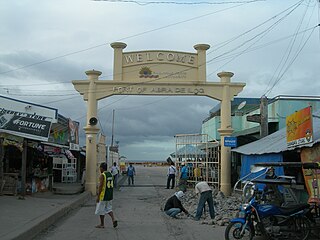
Transportation in the Philippines covers the transportation methods within the archipelagic nation of over 7,600 islands. From a previously underdeveloped state of transportation, the government of the Philippines has been improving transportation through various direct infrastructure projects, and these include an increase in air, sea, road, and rail transportation and transport hubs.

Batangas, officially the Province of Batangas, is a first class province of the Philippines located in the southwestern part of Luzon in the Calabarzon region. Its capital is the city of Batangas, and is bordered by the provinces of Cavite and Laguna to the north, and Quezon to the east. Across the Verde Island Passages to the south is the island of Mindoro and to the west lies the South China Sea. Poetically, Batangas is often referred to by its ancient name, Kumintáng.

Oriental Mindoro, officially the Province of Oriental Mindoro, is a province in the Philippines located on the island of Mindoro under Mimaropa region in Luzon, about 140 kilometres (87 mi) southwest of Manila. The province is bordered by the Verde Island Passage and the rest of Batangas to the north, by Marinduque, Maestre de Campo Island, Tablas Strait and the rest of Romblon to the east, by Semirara and the rest of Caluya Islands, Antique to the south, and by Occidental Mindoro to the west. Its provincial capital Calapan, the only city in the island, is the most-populous in the province, and Mimaropa's regional center.

Southern Tagalog, designated as Region IV, was an administrative region in the Philippines that comprised the current regions of Calabarzon and Mimaropa, the province of Aurora in Central Luzon, and most of the National Capital Region. It was the largest region in the Philippines in terms of both land area and population. After its partition on May 17, 2002, Southern Tagalog continues to exist as a cultural-geographical region.

San Agustín, officially the Municipality of San Agustín,, is a 4th class municipality in the province of Romblon, Philippines. According to the 2020 census, it has a population of 24,115 people.

Calapan, officially the City of Calapan, is a 3rd class component city and the capital of the province of Oriental Mindoro, Philippines. According to the 2020 census, it has a population of 145,786 people making it the most populous in Oriental Mindoro and second in the entire Mindoro Island after San Jose in Occidental Mindoro. The city is also the regional center of Mimaropa region, as well as its second biggest city.
International Container Terminal Services, Inc. (ICTSI) is a global port management company headquartered in Manila, Philippines. Established in 1916, ICTSI is the Philippines' largest multinational and transnational company, having established operations in both developed and emerging market economies in Asia Pacific, the Americas, and Europe, the Middle East and Africa. The company is ranked the eighth largest container terminal operator, according to TEU equity volume.

Montenegro Shipping Lines, Inc. (MSLI) is a Philippine domestic shipping line based at Batangas City, Philippines. The office is located at Montenegro Corporate office, along Bolbok Diversion Road, Bolbok Batangas City. It operates passenger, cargo and RORO vessels to various destinations in the Philippines under the brands Montenegro Lines and Marina Ferries.

The Philippine Nautical Highway System, also the Road Roll-on/Roll-off Terminal System (RRTS) or simply the RoRo System, is an integrated network of highway and vehicular ferry routes which forms the backbone of a nationwide vehicle transport system in the Philippines. It is a system of roads and ports developed by the Philippine government to connect the major islands of Luzon, the Visayas and Mindanao. The 919-kilometer (571 mi) nautical highway was opened to the public on April 12, 2003 as the Strong Republic Nautical Highway (SRNH).

The Port of Manila refers to the collective facilities and terminals that process maritime trade function in harbors in Metro Manila. Located in the Port Area and Tondo districts of Manila, facing Manila Bay, it is the largest and the premier international shipping gateway to the country. The Philippine Ports Authority, a government-owned corporation, manages the Port of Manila and most of the public ports in the country. It is composed of 3 major facilities, namely Manila North Harbor, Manila South Harbor, and the Manila International Container Terminal.

The Port of Subic Bay is in the Subic Bay Freeport Zone, the former U.S. Naval Base Subic Bay, on Subic Bay in the Philippines. It is one of the busiest, largest, historical and most important of ports in the Philippines. The Port is operated and managed by the Subic Bay Metropolitan Authority (SBMA).

The Port of Iloilo is a seaport located in Iloilo City, Philippines. It serves the city, province of Iloilo, and the entire island of Panay in the Western Visayas region of the Philippines. It is located in the districts of Iloilo City Proper and Lapuz, on the southeastern coast of Panay, in Iloilo Strait, and one of the country’s safest and most natural harbors. The Port of Iloilo is managed by the Philippine Ports Authority, a government-owned corporation, and consists of major facilities: the Iloilo River Wharf, Iloilo Domestic Port, and the Visayas Container Terminal.

Philippine Span Asia Carrier Corporation (PSACC), formerly branded as Sulpicio Lines, Inc., is a major shipping line in the Philippines. PSACC is one of the largest domestic shipping and container companies in the Philippines in terms of the number of vessels operated and gross tonnage. The company provides inter-island cargo services throughout the major ports and cities in the Philippines.

Carlos A. Gothong Lines, popularly known as CAGLI and formerly once known as simply Gothong Lines, is a passenger and cargo ferry company based in Cebu, Philippines. CAGLI was formerly a part of WG&A SuperFerry, a company in January 1996 which served 23 major provincial ports throughout the Philippines and was the first domestic shipping company in the country to be certified by the International Safety Management Code standard. CAGLI, William Lines and Aboitiz Shipping formed was the biggest merger in the Philippine shipping industry.

The Port of Piraeus is the sea port of Piraeus, located on the Saronic Gulf on the western coasts of the Aegean Sea, the largest port in Greece and one of the largest in Europe.

2GO Travel or 2GO Sea Solutions, also known simply as 2GO, is a ferry company based in Manila, Philippines, the shipping arm of 2GO Group, and the only remaining Manila-based major interisland ferry company, with its hubs located in Pier 4 at the Manila North Harbor and Batangas International Port.

The Port of Abra de Ilog is a seaport in Abra de Ilog, Occidental Mindoro in the Philippines. It is the main seaport of northern Occidental Mindoro. Household consumption goods are the main cargoes imported in the port while outgoing cargoes are agricultural products such as corn, rice, and livestock. The port has a Passenger Terminal Building which occupies 159 square metres (1,710 sq ft) of space and can accommodate up to 100 people. The port has an two 81 metres (266 ft) RC pier with four ramps for RORO ferries. As of 2023, Montenegro Shipping Lines, Island Water and Besta Shipping Lines have destinations from Abra de Ilog to Batangas, while Caribbean lines has a destination to Balatero.

Starlite Ferries is a passenger ferry company based in Batangas City, Batangas, Philippines owned and operated by Chelsea Logistics Holdings Corp., a Manila-based logistics company. It mainly serves the provinces of Batangas, Oriental Mindoro, Romblon, Aklan, Cebu and Surigao del Norte and is one of the leading ferry companies operating in the Mimaropa and Western Visayas regions.

Archipelago Philippine Ferries Corporation (APFC) is a ferry company based in Muntinlupa, Metro Manila, Philippines. It serves passenger and cargo routes serving select seaports in the Philippines with its fleet of catamaran Roll-on/Roll-off (RoRo) ferries. It also operates ports and terminals.

Asian Marine Transport Corporation (AMTC) is a Filipino passenger and freight shipping company established in 1999 in Cebu City, Philippines. It owns and operates the Super Shuttle RORO, Super Shuttle Ferry and Shuttle Fast Ferry brand of RORO and ROPAX ferries.























